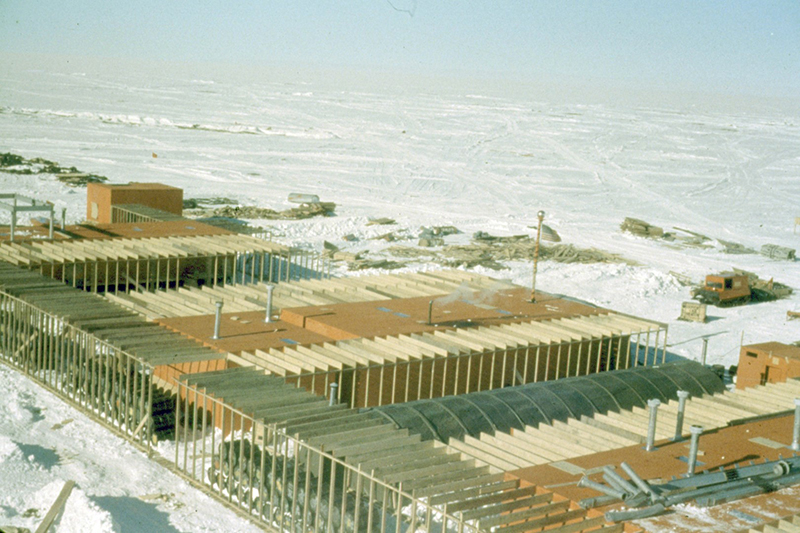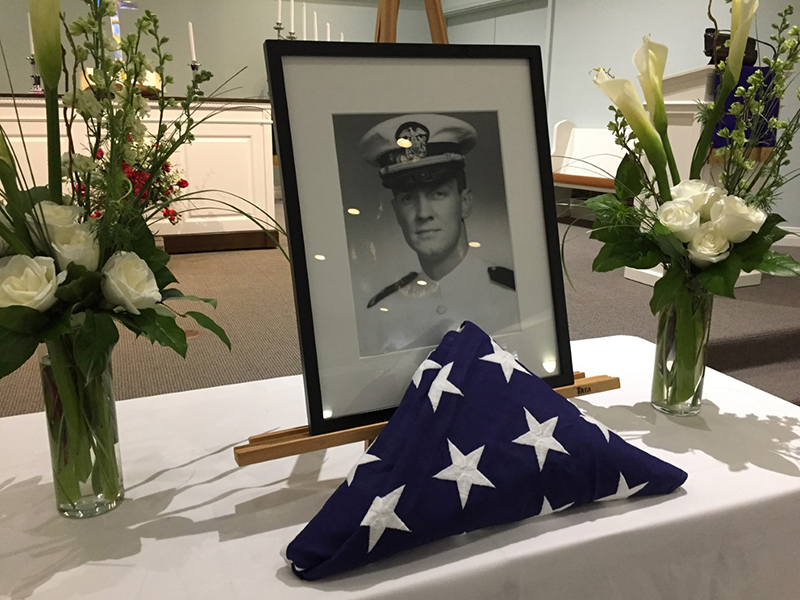
Photo Credit: Dick Prescott |
Dick Bowers (left) and South Pole chief scientist Paul Siple celebrate the first Christmas at the South Pole in December 1956. It was the one day of respite while otherwise working non-stop to build the first South Pole station. |
Appreciation: Dick Bowers, 1928 – 2019
The Seabee Who Built South Pole Station
By Elaine Hood
Posted April 1, 2019
Dick Bowers, the U.S. Navy engineer who led the construction of both McMurdo and South Pole stations has died. Bowers passed away on January 29, 2019, at the age of 90.

Photo Credit: U.S. Navy
The U.S. Navy Seabees who built the first South Pole Station pose for a photo in January 1957. U.S. Navy Lieutenant (Junior Grade) Richard Bowers, leader of the team, is standing at far right, rear.
Bowers, born in 1928 in south-central Pennsylvania, became a career Naval officer after earning a Master's degree in Engineering from Yale in 1952. His career took him around the world, including a tour of duty in Vietnam during the Tet Offensive, but it was his first big assignment, to lead a major construction effort in Antarctica, that was his proudest achievement.
In 1955, the U.S. Navy Construction Battalion, known popularly as the CBs or "Seabees," formed a unit called Mobile Construction Battalion Special to build scientific research stations in Antarctica in advance of the upcoming International Geophysical Year (IGY; 1957-58). The Navy selected Dick Bowers to plan and lead the construction of both McMurdo and South Pole stations. McMurdo was to serve as a base of operations for the crown jewel of the IGY – the South Pole. The Navy could not have chosen a better man than Dick Bowers.
I first met Dick in 2005 at a reunion of the Seabees. This team of men had organized a reunion group called the Antarctic Deep Freeze Association (ADFA), meeting every two years around the nation to keep their friendships alive while reliving the stories of what they had accomplished. Dick's quiet demeanor belied the magnitude of his presence. He would sit quietly off to the side while others, with more raucous personalities, would have the room in gales of laughter recounting stories of the cold and Seabee ingenuity. Dick thoroughly enjoyed these stories and would add his two cents to them, much to the delight of everyone. The men would take their turns sitting next to Dick, paying their respects and visiting with him, as one does with a beloved former boss. He was a man who they honored and truly liked.
The ADFA organization last met in Indianapolis in 2015, choosing the location because it was close to where Dick and his wife were living in retirement. Dick's health no longer permitted him to travel far, so the ADFA committee decided to bring the reunion to him.
Listening to the challenges they faced and the stories about life at the origination of 'Deep Freeze' operations has left me with not only great respect for these men, but also with fond memories of laughing so hard at some of their stories that I was wheezing for air.
It has been a great honor to have met and befriended the men who accomplished what no one else had done before – build entire communities on the coldest, driest, most hostile continent on earth.
Paul Siple, the IGY science leader at Pole, wrote frequently of Bowers in his book 90° South. When the men first arrived to Ross Island in late 1955, they lived in temporary structures surrounding Scott's Discovery Hut. Siple wrote:
Certainly the man most immediately concerned was young Lieutenant (junior grade) Richard A. Bowers of the Navy's Civil Engineer Corps, who was to have charge of building of the South Pole Station. Dick was only twenty-eight, a graduate of Yale and the holder of Master of Arts degrees in two subjects. Dick was tall and slim, possessed a scraggly beard, and was seldom seen outdoors without a brown hood over the top of his orange parka.
Bower's job seemed almost more than any man could handle. With five chief petty officers and seventeen men, he would have to construct a base into which eighteen men could then move to eat, sleep and work at the bottom of the earth. He and I knew that construction of the base would have to be carried out under wretched working conditions that would include bitter cold, possibly strong winds, thin atmosphere, deep but hard snow, and would offer little opportunity for his construction crew to relax, rest, and blow off steam.

Photo Credit: Dick Prescott
U.S. Navy Seabees constructed the first permanent station at the South Pole, December 1956.
Dick's work and demeanor made him a beloved commander not only in Antarctica, but throughout his engineering career. Others, speaking of Dick, almost always use the words "humble, compassionate, and honorable." Others would have to tell you the stories of accomplishments, because he would never boast of them himself.
He was awarded the Moreell Medal, which is presented for outstanding contribution to military engineering by a civilian or military member of the U.S. Navy’s Civil Engineer Corps. Awardees achieved outstanding contribution to military engineering through planning, design, construction, public works, administration, research or development. Dick Bowers was only the second recipient of this medal, achieved for his work in Antarctica. There were other military awards, but you would never learn of them from him.
Author Dian Belanger worked closely with Dick Bowers while researching her book Deep Freeze, the authoritative history of Operation Deep Freeze.
"His Antarctic legacy is central to Deep Freeze, though prying his personal story from him was, in truth, my most challenging interview. In my growing admiration and affection I came to call him 'maddeningly modest,'" Belanger recalled.

Photo Credit: Elaine Hood
Dick Bowers's portrait and folded flag at his memorial service on March 9, 2019.
In many ways, the construction challenges faced today in Antarctica are the same as they were 65 years ago, but today's planners have the benefit of decades of lessons learned. Dick Bowers had to plan construction for a location where none had stepped foot since Amundsen and Scott arrived at the Pole in 1911-1912. No planes had ever landed at the South Pole when the planning was being done in the United States. Cargo was to be air dropped by the Air Force over Pole, but how well would that work in the thin cold air over Pole? How would the men cope living in tents during construction in such extreme conditions? The young Bowers had a tremendous amount of responsibility on his shoulders.
Jerry Marty was the National Science Foundation program officer who oversaw construction of the current South Pole Station, which was dedicated in 2008. He and Dick would meet at the ADFA reunions and compare notes of Pole construction challenges. Marty recently provided these recollections of conversations with Dick Bowers:
I had the honor of meeting Dick at an ADFA reunion in 1998; coincidently the same time as we had begun construction of the new South Pole Station. There was an immediate respect of being in the presence of a leader and someone special. He was characteristically modest and more interested in learning about the construction challenges and progress of the new station than answering my plethora of questions about his 1956/57 IGY South Pole Station Project.
The accomplishments of his Antarctic Deep Freeze became an inspiration and high standard for all of us involved with the new station construction. We often looked over at the location of the buried IGY Station with total respect, commenting in wonder, "Can you believe what Dick Bowers and his team of Seabees did and endured?"
Thanks to his pioneering leadership, construction of the first permanent year-round U.S. Scientific Research station was established at the geographic South Pole, Antarctica. The success of that station became a model for the future which has allowed for sixty-two subsequent years of ongoing and expanding U.S. Scientific research at the South Pole.
As the National Science Foundation now prepares to build a new McMurdo Station, I cannot help but reflect on and be grateful for what Dick Bowers and his crew of U.S. Navy Seabees did.








